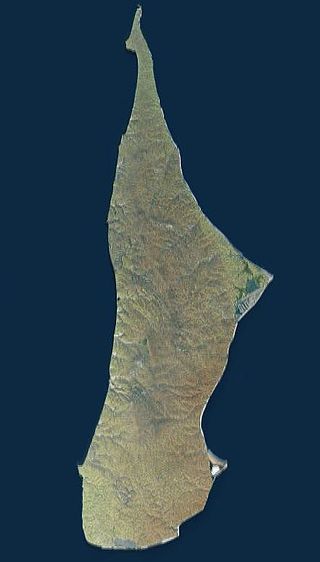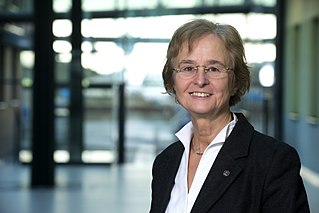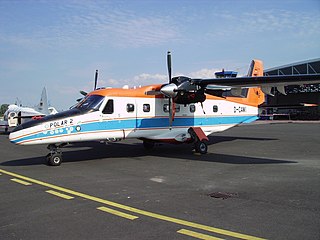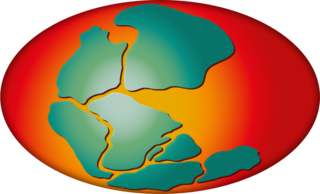Constructor University, formerly Jacobs University Bremen, is an international, private, residential research university located in Vegesack, Bremen, Germany. It offers study programs in engineering, humanities, natural and social sciences, in which students can acquire bachelor's, master's or doctorate degrees.

RV Polarstern is a German research icebreaker of the Alfred Wegener Institute for Polar and Marine Research (AWI) in Bremerhaven, Germany. Polarstern was built by Howaldtswerke-Deutsche Werft in Kiel and Nobiskrug in Rendsburg, was commissioned in 1982, and is mainly used for research in the Arctic and Antarctica. The ship has a length of 118 metres and is a double-hulled icebreaker. She is operational at temperatures as low as −50 °C (−58 °F). Polarstern can break through ice 1.5 m thick at a speed of 5 knots. Thicker ice of up to 3 m (9.8 ft) can be broken by ramming.
The Helmholtz Association of German Research Centres is the largest scientific organisation in Germany. It is a union of 18 scientific-technical and biological-medical research centers. The official mission of the Association is "solving the grand challenges of science, society and industry". Scientists at Helmholtz therefore focus research on complex systems which affect human life and the environment. The namesake of the association is the German physiologist and physicist Hermann von Helmholtz.

The Alfred Wegener Institute, Helmholtz Centre for Polar and Marine Research is located in Bremerhaven, Germany, and a member of the Helmholtz Association of German Research Centres. It conducts research in the Arctic, the Antarctic, and the high and mid latitude oceans. Additional research topics are: North Sea research, marine biological monitoring, and technical marine developments. The institute was founded in 1980 and is named after meteorologist, climatologist, and geologist Alfred Wegener.

Alfred Lothar Wegener was a German climatologist, geologist, geophysicist, meteorologist, and polar researcher.

A research vessel is a ship or boat designed, modified, or equipped to carry out research at sea. Research vessels carry out a number of roles. Some of these roles can be combined into a single vessel but others require a dedicated vessel. Due to the demanding nature of the work, research vessels may be constructed around an icebreaker hull, allowing them to operate in polar waters.

Belkovsky Island is the westernmost island of the Anzhu Islands subgroup of the New Siberian Islands archipelago in the Laptev Sea.

Gotthilf Hempel is a German marine biologist and oceanographer.

Karin Lochte is a German oceanographer, researcher, and climate change specialist. She was director of German Polar Research Alfred Wegener Institute from 2007 to 2017 as well as chairman of the management committee of Jacobs University Bremen.
Quaternary Environment of the Eurasian North, abbreviated QUEEN was an international and interdisciplinary research programme in the Arctic.

Polar 3 was a Dornier 228 owned and operated by the Alfred Wegener Institute that was shot down south of Dakhla, Western Sahara by guerrillas of the Polisario Front on 24 February 1985.

PANGAEA - Data Publisher for Earth & Environmental Science is a digital data library and a data publisher for earth system science. Data can be georeferenced in time and space.
Sea ice thickness spatial extent, and open water within sea ice packs can vary rapidly in response to weather and climate. Sea ice concentration is measured by satellites, with the Special Sensor Microwave Imager / Sounder (SSMIS), and the European Space Agency's Cryosat-2 satellite to map the thickness and shape of the Earth's polar ice cover. The sea ice volume is calculated with the Pan-Arctic Ice Ocean Modeling and Assimilation System (PIOMAS), which blends satellite-observed data, such as sea ice concentrations into model calculations to estimate sea ice thickness and volume. Sea ice thickness determines a number of important fluxes such as heat flux between the air and ocean surface—see below—as well as salt and fresh water fluxes between the ocean since saline water ejects much of its salt content when frozen—see sea ice growth processes. It is also important for navigators on icebreakers since there is an upper limit to the thickness of ice any ship can sail through.

Kohnen-Station is a German summer-only polar research station in the Antarctic, able to accommodate up to 28 people. It is named after the geophysicist Heinz Kohnen (1938–1997), who was for a long time the head of logistics at the Alfred Wegener Institute.
The Deutsches Klima-Konsortium e. V. is located in Berlin, Germany, and represents the leading players of German climate and climate impact research encompassing 26 renowned research organisations. The federation is also an important international partner acting as a guidepost, strategic partner, project partner and information broker.

Martin Stratmann is a German electrochemist and materials scientist. He is one of the directors at the Max-Planck-Institut für Eisenforschung in Düsseldorf since 2000, and heads its department of Interface Chemistry and Surface Engineering.

Bettina Meyer is a German Antarctic researcher, best known for her work on the ecology and physiology of invertebrates in the pelagic zone. She is the head of the ecophysiology of pelagic key species working group at the Alfred Wegener Institute for Polar and Marine Research (AWI).

Cornelia Lüdecke is a German polar researcher and author. A leading figure in the history of German polar research and the history of meteorology and oceanography, she founded the Expert Group on History of Antarctic Research within the Scientific Committee on Antarctic Research (SCAR), institutionalising historical study and reflection for the Antarctic scientific community. Her books, among others, about the Schwabenland Expedition to Antarctica during the Third Reich and Germans in the Antarctic are milestones in the history of polar research publications.
Filchner Station was a German research station in the Antarctic. Administered by the Alfred Wegener Institute for Polar and Marine Research, it was established in February 1982 on the Filchner–Ronne Ice Shelf. The first station in Antarctica to be mounted on jacks, the structure was raised each year to allow for the increase in height of the shelf by snowfall. It was also relocated around 1 kilometre (0.62 mi) southwards each year to account for drift of the ice shelf. In October 1998, Filchner Station was stranded on iceberg A-38 when it broke away from the ice shelf. Research operations were cancelled and an emergency salvage operation was carried out that removed the majority of the station by February 1999.
Polarforschung is a biannual peer-reviewed open-access academic journal published by Copernicus Publications on behalf of the German Society for Polar Research and the Alfred Wegener Institute for Polar and Marine Research. It was established in 1931, with articles appearing both in English and German. It covers a range of topics broadly related to the fields of polar, glaciological, and high-mountain research. Historically, reports from polar expeditions and reviews on polar topics were published as well. Though the journal originally published only on topics within the natural sciences, the current version of the journal includes contributions from an expanded range of polar and high-mountain research disciplines, including biology and ecology, geology and geophysics, geodesy and glaciology, permafrost, oceanography, climate and meteorology, history and social sciences, education, and outreach and knowledge transfer. The journal publishes scientific articles, review articles, reports for the polar community, teaching materials or concepts, and book reviews, alongside news and updates from the German Society for Polar Research, the Association of Polar Early Career Scientists Germany Board, and relevant conference reports. The journal no longer accepts manuscripts which show yet-unpublished or original data and results, and instead focuses on scientific articles with an overarching thematic focus.












